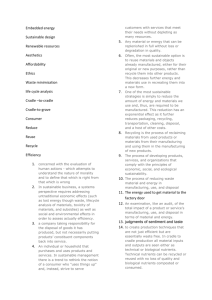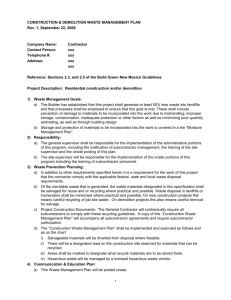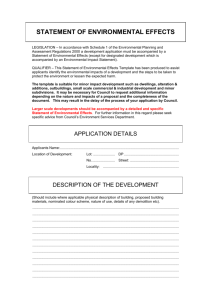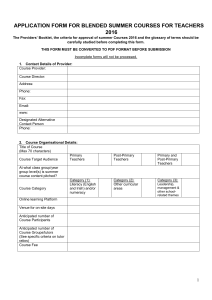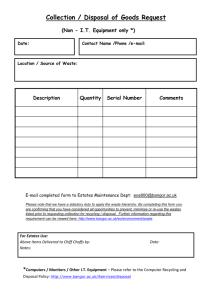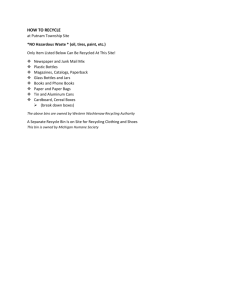3) - Winger Contracting Company
advertisement
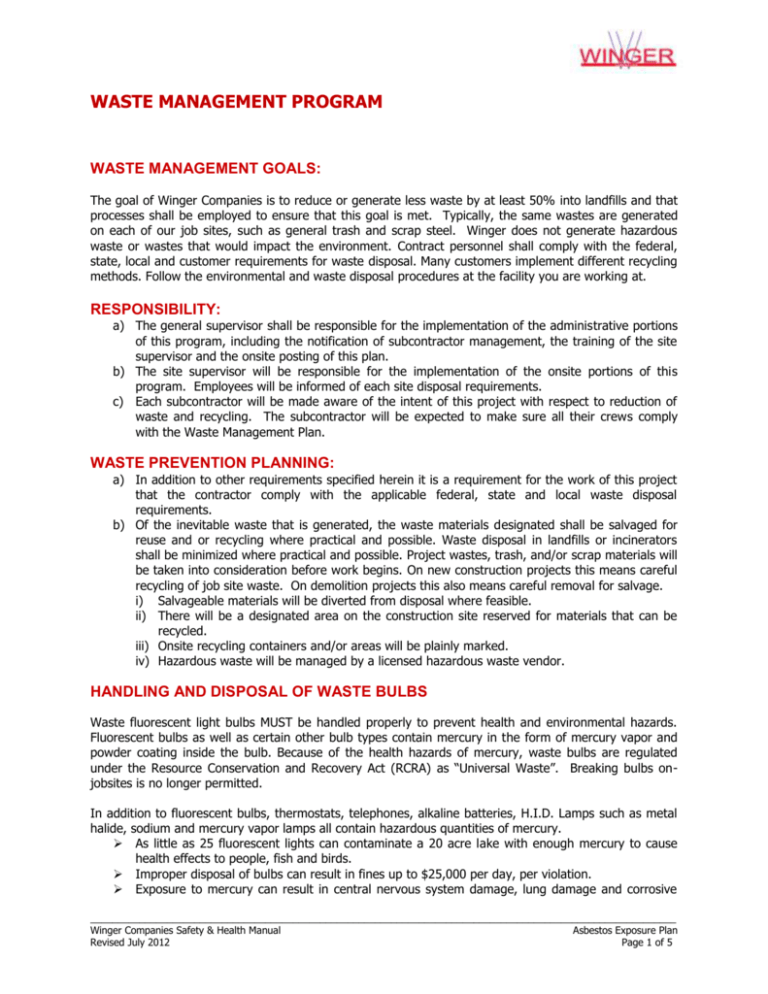
WASTE MANAGEMENT PROGRAM WASTE MANAGEMENT GOALS: The goal of Winger Companies is to reduce or generate less waste by at least 50% into landfills and that processes shall be employed to ensure that this goal is met. Typically, the same wastes are generated on each of our job sites, such as general trash and scrap steel. Winger does not generate hazardous waste or wastes that would impact the environment. Contract personnel shall comply with the federal, state, local and customer requirements for waste disposal. Many customers implement different recycling methods. Follow the environmental and waste disposal procedures at the facility you are working at. RESPONSIBILITY: a) The general supervisor shall be responsible for the implementation of the administrative portions of this program, including the notification of subcontractor management, the training of the site supervisor and the onsite posting of this plan. b) The site supervisor will be responsible for the implementation of the onsite portions of this program. Employees will be informed of each site disposal requirements. c) Each subcontractor will be made aware of the intent of this project with respect to reduction of waste and recycling. The subcontractor will be expected to make sure all their crews comply with the Waste Management Plan. WASTE PREVENTION PLANNING: a) In addition to other requirements specified herein it is a requirement for the work of this project that the contractor comply with the applicable federal, state and local waste disposal requirements. b) Of the inevitable waste that is generated, the waste materials designated shall be salvaged for reuse and or recycling where practical and possible. Waste disposal in landfills or incinerators shall be minimized where practical and possible. Project wastes, trash, and/or scrap materials will be taken into consideration before work begins. On new construction projects this means careful recycling of job site waste. On demolition projects this also means careful removal for salvage. i) Salvageable materials will be diverted from disposal where feasible. ii) There will be a designated area on the construction site reserved for materials that can be recycled. iii) Onsite recycling containers and/or areas will be plainly marked. iv) Hazardous waste will be managed by a licensed hazardous waste vendor. HANDLING AND DISPOSAL OF WASTE BULBS Waste fluorescent light bulbs MUST be handled properly to prevent health and environmental hazards. Fluorescent bulbs as well as certain other bulb types contain mercury in the form of mercury vapor and powder coating inside the bulb. Because of the health hazards of mercury, waste bulbs are regulated under the Resource Conservation and Recovery Act (RCRA) as “Universal Waste”. Breaking bulbs onjobsites is no longer permitted. In addition to fluorescent bulbs, thermostats, telephones, alkaline batteries, H.I.D. Lamps such as metal halide, sodium and mercury vapor lamps all contain hazardous quantities of mercury. As little as 25 fluorescent lights can contaminate a 20 acre lake with enough mercury to cause health effects to people, fish and birds. Improper disposal of bulbs can result in fines up to $25,000 per day, per violation. Exposure to mercury can result in central nervous system damage, lung damage and corrosive ___________________________________________________________________________________________________________ Winger Companies Safety & Health Manual Asbestos Exposure Plan Revised July 2012 Page 1 of 5 effects on exposed skin. Mercury vaporizes rapidly at room temperature presenting and inhalation hazard. It can also be absorbed through the skin. Containers of bulbs cannot be stored for more than one year. All Universal Wastes MUST be disposed of by a licensed disposal firm. Arrangements MUST be made for waste bulbs to be picked up on-site or returned to the main office for disposal. Large quantities of waste bulbs should be collected for on-site pick-up by a licensed waste disposal service. Smaller quantities of bulbs can be returned to the shop for collection and proper disposal. Spills of PCB oil from ballasts, switchgear, or transformers MUST be properly cleaned up. Immediately cordon off the spill area and notify the project manager and any facility environmental representatives. (There are specific notification, testing and clean-up requirements under Federal regulations). TRASH AND RECYCLED WASTE All trash MUST be disposed of properly. Place scrap materials in designated dumpsters marked for recycling. ALWAYS cut long pieces up. DO NOT place scrap materials in dumpster longer than the length of designated dumpster. The following chart identifies waste materials expected on projects, their expected disposal methods and handling procedures. New items may be added as needed. Material Beverage/Pop Cans Quantity Disposal Method Recycle locally Handling Procedure Keep separated in designated areas onsite. Cardboard Recycle locally Keep clean cardboard separated in designated areas onsite. Dirty cardboard must be placed in general trash dumpster. Carpet and pad Reuse or recycle with carpet. Manufacturer Clean dimensional wood and palette wood Keep separate for reuse by on-site construction or by site employees for either heating stoves or reuse in home projects. May be offered to public. Keep separated in designated areas onsite. Concrete, Concrete Masonry Units Recycle when possible. Keep separated in designated areas onsite ___________________________________________________________________________________________________________ Winger Companies Safety & Health Manual Asbestos Exposure Plan Revised July 2012 Page 2 of 5 Material Florescent Bulbs Quantity Disposal Method Keep separate for recycling or proper disposal. Handling Procedure Keep separated in designated areas onsite for pick up. Gas Cylinders Recycle with supplier. Keep in separated area onsite designated for pickup. Glass Glass Bottles: recycle locally. Keep separated in designated areas onsite. Gypsum drywall (unpainted) Recycle with supplier when possible. Keep scraps separate for recycling – stack on pallets in provided onsite. Insulation Reuse, landfill. Use proper PPE Land clearing debris Keep separate for reuse and Keep separated in or wood sale. Suitable designated areas onsite. materials may be delivered to a composting site. Separate topsoil and rock for future excavation or landscaping use. Metal Scraps: Aluminum Carbon Steel Copper Wire Galvanized Siding Stainless Steel Recycle off site when possible. Separate copper wire when possible. Place in designated “carbon steel, stainless steel, copper, etc.” containers for pick up. Cut pieces so they do not extend past the outside perimeter of trash dumpster. Oils, Fuels Recycle when possible. Keep separated in properly labeled containers for pick up. Oils and fuels must not be poured or flushed down drains. Environmental procedures must be ___________________________________________________________________________________________________________ Winger Companies Safety & Health Manual Asbestos Exposure Plan Revised July 2012 Page 3 of 5 Material Quantity Disposal Method Handling Procedure followed to eliminate contamination of soil. Paint Reuse onsite; donate to Habitat for Humanity Restore; paint must be in solid state before taking to landfill, spread on newspapers or cardboard and let air dry. Paint containers/cans should be opened and dry. Keep separated in designated areas onsite. Paper, magazines, catalogs, and newsprint Recycle locally Keep separated in designate blue containers onsite. Personal household or non-work related waste Personal household or nonDo not bring onsite. work related waste must be disposed of through personal means. Plastics Plastic Bottles: recycle Keep separated in locally; be aware of plastics designated areas onsite. that are acceptable to recycle facility. Plywood, OSB, particle board, painted or treated wood Reuse onsite when possible, landfill or recycle off site. Keep separated in designated areas onsite. Place in “Trash” container if dirty or contaminated. Pipe, fittings, flanges etc. Recycle when possible Cut long pieces so they do not extend longer than the dumpster Tires Recycle when possible Keep separated in designated areas onsite. ___________________________________________________________________________________________________________ Winger Companies Safety & Health Manual Asbestos Exposure Plan Revised July 2012 Page 4 of 5 ___________________________________________________________________________________________________________ Winger Companies Safety & Health Manual Asbestos Exposure Plan Revised July 2012 Page 5 of 5
